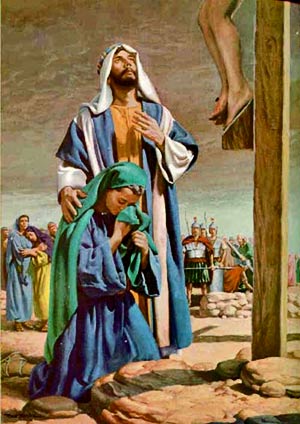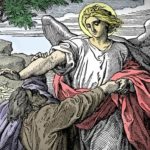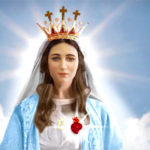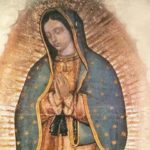Today’s Gospel takes us back to the birth of the Church, instituting Blessed Virgin Mary in a special position within her, as mother of all Christians. Jesus last gesture of love, already on the cross, is the gift of his own Mother. This is done in the beautiful dialogue in which he unites his mother and the beloved disciple as mother and child: “Woman, this is your son … this is your mother” (Jn 19,26.27).
When Jesus saw his mother and the disciple there whom he loved, he said to his mother, “Woman, behold, your son.”
Then he said to the disciple, “Behold, your mother.” And from that hour the disciple took her into his home.Gospel, Saint John 19,25-27.
Before experiencing death, Jesus wanted these two people, united to him very closely – as a mother and as a disciple – to belong to each other. It was not their decision, but of Jesus himself.
The disciple becomes “son of Mary”, he receives the warmth and love a mother has for her children, her teaching, her protection and care, her comfort in times of sadness.
But Jesus also thought of Mary, He did not leave her alone and unprotected, but gave her a disciple as a child who will respect her, be attentive to her word, be obedient to her requests and take the mother to those places where her presence is required.
In Mary’s love as a sorrowful mother who suffers for all humanity and the Church, it is present Jesus extreme love. Mary’s pain is not one that encloses itself, falling into despair. It is rather a fruitful pain. In that decisive “hour” Mary becomes Mother again, a new birth takes place in her, fruitful of love. The motherhood of Mary expands to embrace in itself the “beloved disciple” and in him the whole Church of which he is a figure at that moment.
 They will now have new relationships: “the mother of Jesus” (v. 25), presented later as “the mother” (v. 26), has to become the mother of the disciple (v. 27); and he will be her son. Therefore, “the corporal motherhood of Mary with the Son of God, gives the foundation to a spiritual motherhood, that is her fulfillment” (f. Grelot, María, in DSAM X, 420).
They will now have new relationships: “the mother of Jesus” (v. 25), presented later as “the mother” (v. 26), has to become the mother of the disciple (v. 27); and he will be her son. Therefore, “the corporal motherhood of Mary with the Son of God, gives the foundation to a spiritual motherhood, that is her fulfillment” (f. Grelot, María, in DSAM X, 420).
“The inexhaustible reach of this symbolism intimately connects the mystery of the Church with the mystery of Mary” (f. Grelot, 1.c.). From that “hour” a welcome like the one provided by the disciple is demanded to “all generations of disciples and of all those who confess and love Christ” (John Paul II, Redemptor hominis 22). But if Mary is here “image and principle of the Church” (LG 68), she is at the same time “mother of the Church, that is, of all the people of God” (Paul VI); “the mother of the members of Christ, that we are” (Saint Augustine, o.c.), because she becomes the mother of all the disciples of Jesus.
What this spiritual maternity consists of? The “woman” who had been the mother of Jesus becomes the spiritual mother of the brothers of Jesus, making them “conform to the image of her Son” (cf. Rom 8:29), that is, similar to Jesus: The son of Mary is Jesus … (His word: ‘Behold, your son’ …, is equivalent to saying: ‘This is Jesus, whom you gave birth to.’) In effect, the one who is perfect ‘no longer lives he’, but in him ‘Christ lives’, and since Christ lives in him, it is legitimate to say to Mary: ‘Behold your son’, another Christ (In Ev. Job. I, 23: PG 14,32).
Mary in the Catechism of the Catholic Church (CCC):
- Mary, Mother of the Church
- Devotion to the Blessed Virgin is intrinsic to Christian worship, without thereby constituting adoration
- The victorious Church venerates Mary by honoring her as she deserves
- Mary is a collaborator in the work of redemption
- Mary continues her maternal role in Heaven on behalf of the members of Christ
- The Commandments also lead us to honor Mary in her role as Mother
- Mary, intercessor in our favor and key to miracles
- Mary full of grace and seat of wisdom
Mary, Mother of the Church
Since the Virgin Mary’s role in the mystery of Christ and the Spirit has been treated, it is fitting now to consider her place in the mystery of the Church. “The Virgin Mary . . . is acknowledged and honored as being truly the Mother of God and of the redeemer…. She is ‘clearly the mother of the members of Christ’ … since she has by her charity joined in bringing about the birth of believers in the Church, who are members of its head.” (LG 53; cf. St. Augustine, De virg. 6: PL 40,399.) “Mary, Mother of Christ, Mother of the Church.” (Paul VI, Discourse, November 21,1964.) (CCC 963)
At the end of this mission of the Spirit, Mary became the Woman, the new Eve (“mother of the living”), the mother of the “whole Christ.” (Cf. Jn 19:25-27). As such, she was present with the Twelve, who “with one accord devoted themselves to prayer,” (Acts 1:14), at the dawn of the “end time” which the Spirit was to inaugurate on the morning of Pentecost with the manifestation of the Church. (CCC 726)
Mary gave her consent in faith at the Annunciation and maintained it without hesitation at the foot of the Cross. Ever since, her motherhood has extended to the brothers and sisters of her Son “who still journey on earth surrounded by dangers and difficulties.” (LG 62). Jesus, the only mediator, is the way of our prayer; Mary, his mother and ours, is wholly transparent to him: she “shows the way” (hodigitria), and is herself “the Sign” of the way, according to the traditional iconography of East and West. (CCC 2674)
Mary’s role in the Church is inseparable from her union with Christ and flows directly from it. “This union of the mother with the Son in the work of salvation is made manifest from the time of Christ’s virginal conception up to his death”; (LG 57) it is made manifest above all at the hour of his Passion:
Thus the Blessed Virgin advanced in her pilgrimage of faith, and faithfully persevered in her union with her Son unto the cross. There she stood, in keeping with the divine plan, enduring with her only begotten Son the intensity of his suffering, joining herself with his sacrifice in her mother’s heart, and lovingly consenting to the immolation of this victim, born of her: to be given, by the same Christ Jesus dying on the cross, as a mother to his disciple, with these words: “Woman, behold your son.” (LG 58; cf. Jn 19:26-27). (CCC 964)
Mary is the perfect Orans (prayer), a figure of the Church. When we pray to her, we are adhering with her to the plan of the Father, who sends his Son to save all men. Like the beloved disciple we welcome Jesus’ mother into our homes, (Cf. Jn 19:27.) for she has become the mother of all the living. We can pray with and to her. the prayer of the Church is sustained by the prayer of Mary and united with it in hope. (Cf. LG 68-69.) (CCC 2679)
Holy Mary, Mother of God: With Elizabeth we marvel, “and why is this granted me, that the mother of my Lord should come to me?” (Lk 1:43.) Because she gives us Jesus, her son, Mary is Mother of God and our mother; we can entrust all our cares and petitions to her: she prays for us as she prayed for herself: “Let it be to me according to your word.” (Lk 1:38). By entrusting ourselves to her prayer, we abandon ourselves to the will of God together with her: “Thy will be done.”
Pray for us sinners, now and at the hour of our death: By asking Mary to pray for us, we acknowledge ourselves to be poor sinners and we address ourselves to the “Mother of Mercy,” the All-Holy One. We give ourselves over to her now, in the Today of our lives. and our trust broadens further, already at the present moment, to surrender “the hour of our death” wholly to her care. May she be there as she was at her son’s death on the cross. May she welcome us as our mother at the hour of our passing (Cf. Jn 19:27) to lead us to her son, Jesus, in paradise. (CCC 2677)
This twofold movement of prayer to Mary has found a privileged expression in the Ave Maria:
Hail Mary [or Rejoice, Mary]: the greeting of the angel Gabriel opens this prayer. It is God himself who, through his angel as intermediary, greets Mary. Our prayer dares to take up this greeting to Mary with the regard God had for the lowliness of his humble servant and to exult in the joy he finds in her. (Cf. Lk 1:48; Zeph 3:17b.)
Full of grace, the Lord is with thee: These two phrases of the angel’s greeting shed light on one another. Mary is full of grace because the Lord is with her. the grace with which she is filled is the presence of him who is the source of all grace. “Rejoice . . . O Daughter of Jerusalem . . . the Lord your God is in your midst.” (Zeph 3:14, 17a.) Mary, in whom the Lord himself has just made his dwelling, is the daughter of Zion in person, the ark of the covenant, the place where the glory of the Lord dwells. She is “the dwelling of God . . . with men.” (Rev 21:3.) Full of grace, Mary is wholly given over to him who has come to dwell in her and whom she is about to give to the world.
Blessed art thou among women and blessed is the fruit of thy womb, Jesus. After the angel’s greeting, we make Elizabeth’s greeting our own. “Filled with the Holy Spirit,” Elizabeth is the first in the long succession of generations who have called Mary “blessed.” (Lk 1:41, 48.) “Blessed is she who believed….” (Lk 1:45.) Mary is “blessed among women” because she believed in the fulfillment of the Lord’s word. Abraham. because of his faith, became a blessing for all the nations of the earth. (Cf. Gen 12:3). Mary, because of her faith, became the mother of believers, through whom all nations of the earth receive him who is God’s own blessing: Jesus, the “fruit of thy womb.” (CCC 2676)
Devotion to the Blessed Virgin is intrinsic to Christian worship, without thereby constituting adoration
“All generations will call me blessed”: “The Church’s devotion to the Blessed Virgin is intrinsic to Christian worship.” (Lk 1:48; Paul VI, MC 56.) The Church rightly honors “the Blessed Virgin with special devotion. From the most ancient times the Blessed Virgin has been honored with the title of ‘Mother of God,’ to whose protection the faithful fly in all their dangers and needs…. This very special devotion … differs essentially from the adoration which is given to the incarnate Word and equally to the Father and the Holy Spirit, and greatly fosters this adoration.” (LG 66) The liturgical feasts dedicated to the Mother of God and Marian prayer, such as the rosary, an “epitome of the whole Gospel,” express this devotion to the Virgin Mary. (Cf. Paul VI, MC 42; SC 103.) (CCC 971)
The victorious Church venerates Mary by honoring her as she deserves
After speaking of the Church, her origin, mission, and destiny, we can find no better way to conclude than by looking to Mary. In her we contemplate what the Church already is in her mystery on her own “pilgrimage of faith,” and what she will be in the homeland at the end of her journey. There, “in the glory of the Most Holy and Undivided Trinity,” “in the communion of all the saints,” (LG 69). The Church is awaited by the one she venerates as Mother of her Lord and as her own mother.
In the meantime the Mother of Jesus, in the glory which she possesses in body and soul in heaven, is the image and beginning of the Church as it is to be perfected in the world to come. Likewise she shines forth on earth until the day of the Lord shall come, a sign of certain hope and comfort to the pilgrim People of God. (LG 68; Cf. 2 Pet 3 10.) (CCC 972)
Mary is a collaborator in the work of redemption
By pronouncing her “fiat” at the Annunciation and giving her consent to the Incarnation, Mary was already collaborating with the whole work her Son was to accomplish. She is mother wherever he is Savior and head of the Mystical Body. (CCC 973)
Her role in relation to the Church and to all humanity goes still further. “In a wholly singular way she cooperated by her obedience, faith, hope, and burning charity in the Savior’s work of restoring supernatural life to souls. For this reason she is a mother to us in the order of grace.” (LG 61). (CCC 968)
“God sent forth his Son”, but to prepare a body for him, ( Gal 4:4; Heb 10:5.) he wanted the free co-operation of a creature. For this, from all eternity God chose for the mother of his Son a daughter of Israel, a young Jewish woman of Nazareth in Galilee, “a virgin betrothed to a man whose name was Joseph, of the house of David; and the virgin’s name was Mary”: (Lk 1:26-27.)
The Father of mercies willed that the Incarnation should be preceded by assent on the part of the predestined mother, so that just as a woman had a share in the coming of death, so also should a woman contribute to the coming of life. (LG 56; cf. LG 61.) (CCC 488)
At the announcement that she would give birth to “the Son of the Most High” without knowing man, by the power of the Holy Spirit, Mary responded with the obedience of faith, certain that “with God nothing will be impossible”: “Behold, I am the handmaid of the Lord; let it be [done] to me according to your word.” (Lk 1:28-38; cf. Rom 1:5.) Thus, giving her consent to God’s word, Mary becomes the mother of Jesus. Espousing the divine will for salvation wholeheartedly, without a single sin to restrain her, she gave herself entirely to the person and to the work of her Son; she did so in order to serve the mystery of redemption with him and dependent on him, by God’s grace: (Cf. LG 56.)
As St. Irenaeus says, “Being obedient she became the cause of salvation for herself and for the whole human race.” (St. Irenaeus, Adv. haeres. 3, 22, 4: PG 7/1, 959A.) Hence not a few of the early Fathers gladly assert. . .: “The knot of Eve’s disobedience was untied by Mary’s obedience: what the virgin Eve bound through her disbelief, Mary loosened by her faith.” (St. Irenaeus, Adv. haeres. 3, 22, 4: PG 7/1, 959A.) Comparing her with Eve, they call Mary “the Mother of the living” and frequently claim: “Death through Eve, life through Mary.” (LC 56; St. Epiphanius, Panarion 2, 78, 18: PG 42, 728CD-729AB; St. Jerome, Ep. 22, 21: PL 22, 408.) (CCC 494)
The Virgin Mary “co-operated through free faith and obedience in human salvation” (LG 56). She uttered her yes “in the name of all human nature” (St. Thomas Aquinas, S Th III, 30, 1). By her obedience she became the new Eve, mother of the living. (CCC 511)
Mary continues her maternal role in Heaven on behalf of the members of Christ
“We believe that the Holy Mother of God, the new Eve, Mother of the Church, continues in heaven to exercise her maternal role on behalf of the members of Christ” (Paul VI, CPG # 15). (CCC 975)
The Commandments also lead us to honor Mary in her role as Mother
Grave matter is specified by the Ten Commandments, corresponding to the answer of Jesus to the rich young man: “Do not kill, Do not commit adultery, Do not steal, Do not bear false witness, Do not defraud, Honor your father and your mother.” (Mk 10:19.) The gravity of sins is more or less great: murder is graver than theft. One must also take into account who is wronged: violence against parents is in itself graver than violence against a stranger. (CCC 1858)
Filial respect is shown by true docility and obedience. “My son, keep your father’s commandment, and forsake not your mother’s teaching…. When you walk, they will lead you; when you lie down, they will watch over you; and when you awake, they will talk with you.” (Prov 6:20-22.) “A wise son hears his father’s instruction, but a scoffer does not listen to rebuke.” (Prov 13:1). (CCC 2216)
The fourth commandment reminds grown children of their responsibilities toward their parents. As much as they can, they must give them material and moral support in old age and in times of illness, loneliness, or distress. Jesus recalls this duty of gratitude. (Cf. Mk 7:10-12).
For the Lord honored the father above the children, and he confirmed the right of the mother over her sons. Whoever honors his father atones for sins, and whoever glorifies his mother is like one who lays up treasure. Whoever honors his father will be gladdened by his own children, and when he prays he will be heard. Whoever glorifies his father will have long life, and whoever obeys the Lord will refresh his mother. (Sir 3:2-6).
O son, help your father in his old age, and do not grieve him as long as he lives; even if he is lacking in understanding, show forbearance; in all your strength do not despise him…. Whoever forsakes his father is like a blasphemer, and whoever angers his mother is cursed by the Lord. (Sir 3:12.16). (CCC 2218)
Mary, intercessor in our favor and key to miracles
On the threshold of his public life Jesus performs his first sign – at his mother’s request – during a wedding feast. (Cf. Jn 2:1-11.) The Church attaches great importance to Jesus’ presence at the wedding at Cana. She sees in it the confirmation of the goodness of marriage and the proclamation that thenceforth marriage will be an efficacious sign of Christ’s presence. (CCC 1613)
The Gospel reveals to us how Mary prays and intercedes in faith. At Cana, (Cf. Jn 2:1-12.) The mother of Jesus asks her son for the needs of a wedding feast; this is the sign of another feast – that of the wedding of the Lamb where he gives his body and blood at the request of the Church, his Bride. It is at the hour of the New Covenant, at the foot of the cross, (Cf. Jn 19:25-27.) that Mary is heard as the Woman, the new Eve, the true “Mother of all the living.” (CCC 2618)
Mary full of grace and seat of wisdom
Mary, the all-holy ever-virgin Mother of God, is the masterwork of the mission of the Son and the Spirit in the fullness of time. For the first time in the plan of salvation and because his Spirit had prepared her, the Father found the dwelling place where his Son and his Spirit could dwell among men. In this sense the Church’s Tradition has often read the most beautiful texts on wisdom in relation to Mary. (Cf. Prov 8:1-9; 8:6; Sir 24). Mary is acclaimed and represented in the liturgy as the “Seat of Wisdom.”
In her, the “wonders of God” that the Spirit was to fulfill in Christ and the Church began to be manifested. (CCC 721)
The Holy Spirit prepared Mary by his grace. It was fitting that the mother of him in whom “the whole fullness of deity dwells bodily” (Col 2:9). should herself be “full of grace.” She was, by sheer grace, conceived without sin as the most humble of creatures, the most capable of welcoming the inexpressible gift of the Almighty. It was quite correct for the angel Gabriel to greet her as the “Daughter of Zion”: “Rejoice.” (Cf. Zeph 3:14; Zech 2:14). It is the thanksgiving of the whole People of God, and thus of the Church, which Mary in her canticle (Cf. Lk 1:46-55). lifts up to the Father in the Holy Spirit while carrying within her the eternal Son. (CCC 722)
Header image: Passion of the Christ, film.




